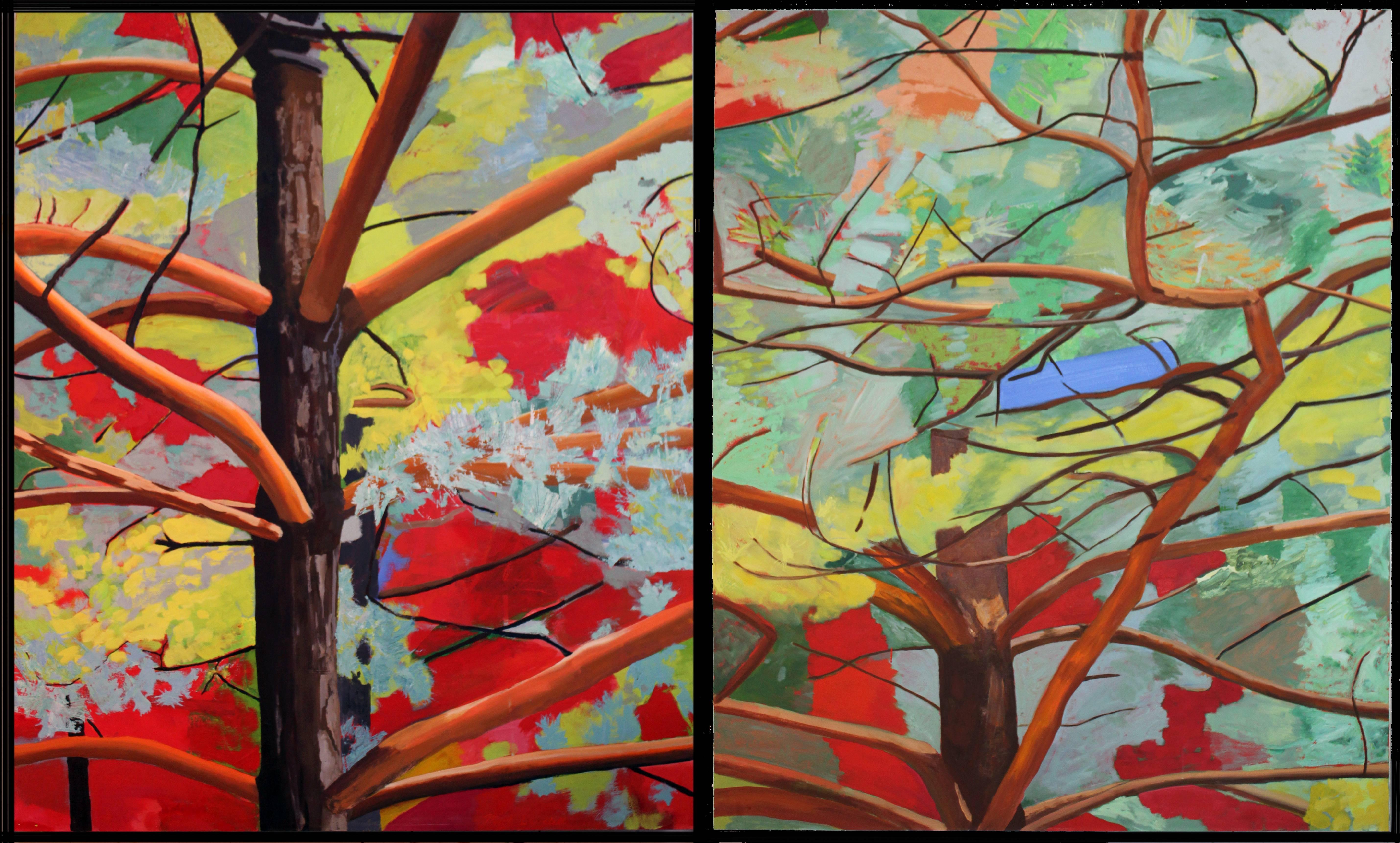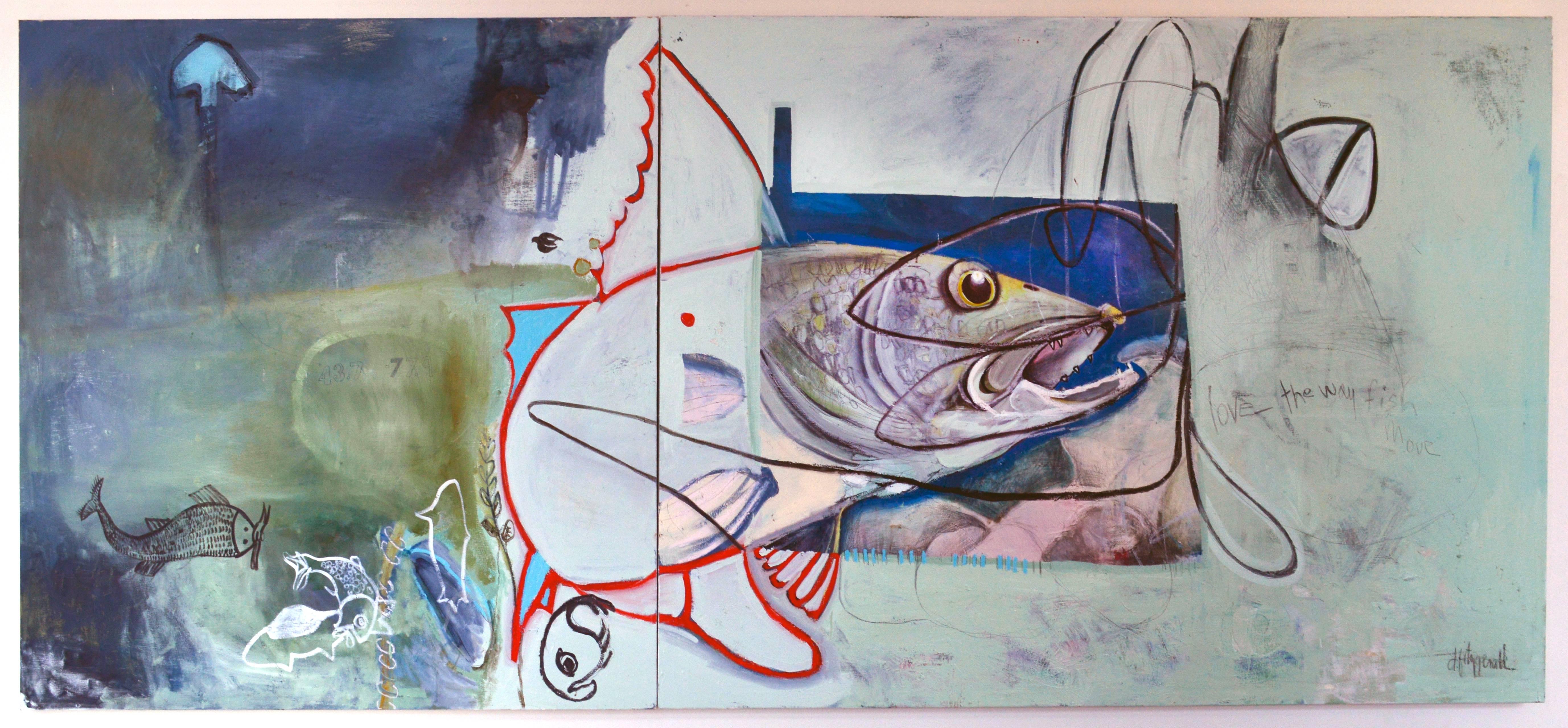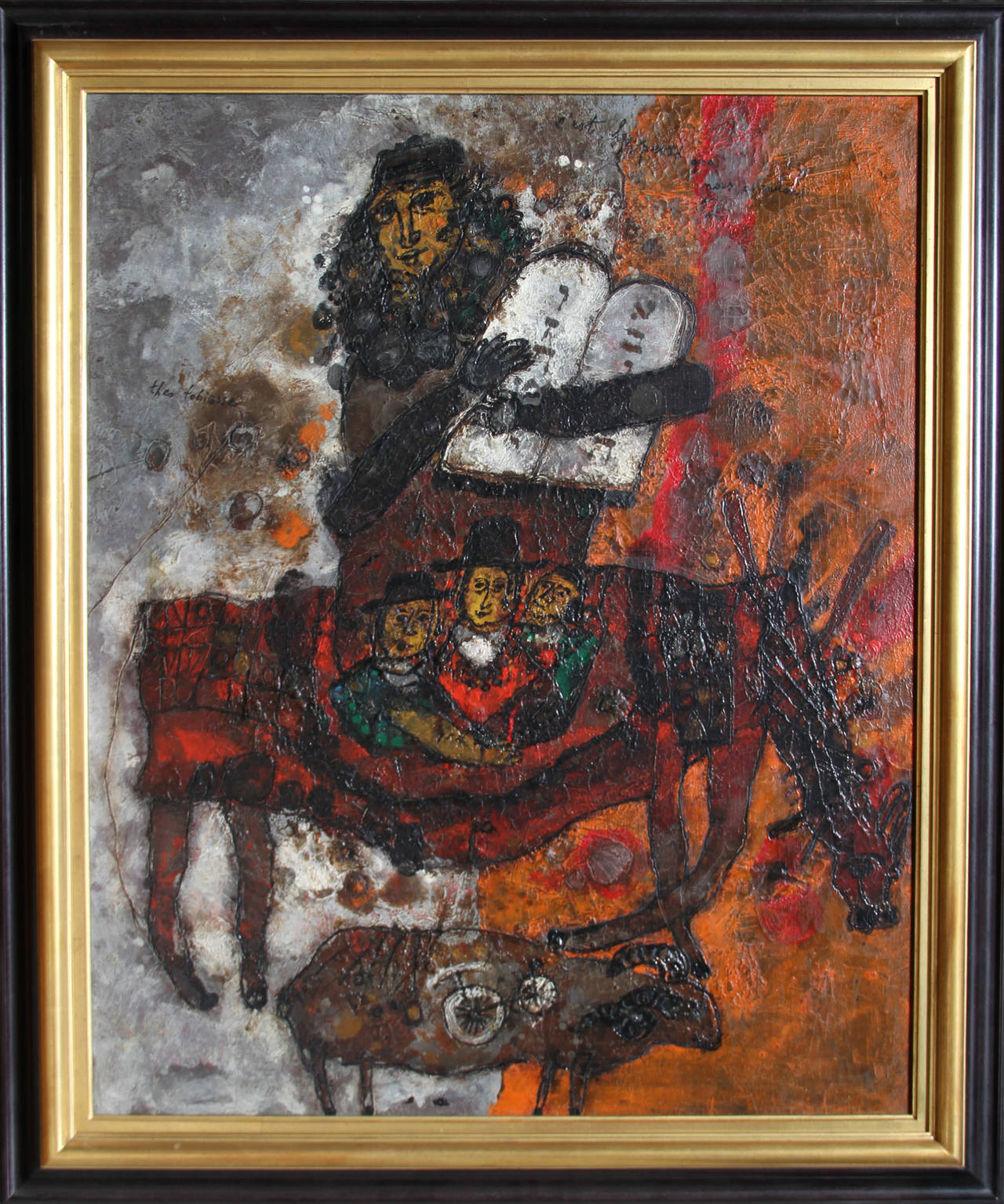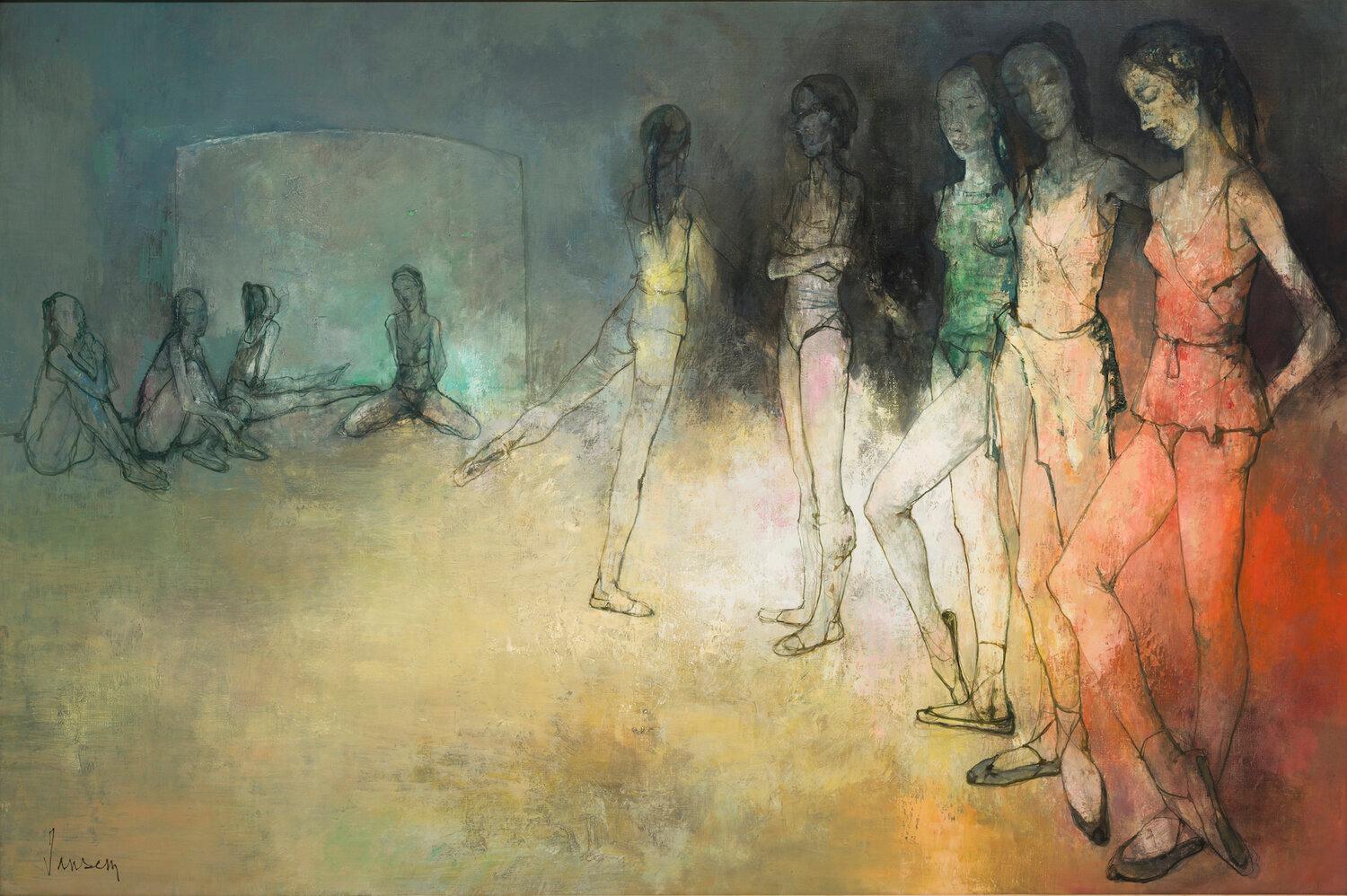Items Similar to Rabbi in Old Jerusalem Painting
Want more images or videos?
Request additional images or videos from the seller
Isaac FrenelRabbi in Old Jerusalem Painting
About the Item
Yitzchak Frenel Frenkel, Israeli Master
In 1920, he established the artists' cooperative in Jaffa and an artists' studio in Herzliya. Later that year, he traveled to Paris where he studied at the École des Beaux-Arts and at the Académie de la Grande Chaumière at the studios of the sculptor Antoine Bourdelle and painter Henri Matisse. He was one of the leading Jewish artists of École de Paris. Frenkel returned to Palestine in 1925 and opened the Histadrut Art School in Tel Aviv. His students included Shimshon Holzman, Mordechai Levanon, David Hendler, Joseph Kossonogi, and Siona Tagger. He was a mentor to Bezalel students Avigdor Stematsky, Yehezkel Streichman, Moshe Castel, and Arie Aroch.
Frenkel's style was closer to the abstract painting to which he was exposed in Paris than the orientalism that was popular in Jerusalem, Palestine (Israel) at that time. In 1934, he settled in Safed. There he painted the ancient Judaic synagogues, narrow lanes, local inhabitants and surrounding countryside. In 1973, his house reopened as a museum showcasing his work. In July 1978, Frenkel had a one-man show at the Orangerie in Paris. This is a fine Judaica piece
- Creator:Isaac Frenel (1899-1981, Ukrainian)
- Dimensions:Height: 24 in (60.96 cm)Width: 20.25 in (51.44 cm)
- Medium:
- Movement & Style:
- Period:
- Condition:
- Gallery Location:Surfside, FL
- Reference Number:1stDibs: LU38210934792
About the Seller
4.9
Platinum Seller
These expertly vetted sellers are 1stDibs' most experienced sellers and are rated highest by our customers.
Established in 1995
1stDibs seller since 2014
1,553 sales on 1stDibs
Typical response time: 1 hour
- ShippingRetrieving quote...Ships From: Surfside, FL
- Return PolicyA return for this item may be initiated within 3 days of delivery.
More From This SellerView All
- French Jewish Post Holocaust Abstract Painting Manner of Hundertwasser Art BrutBy Jichak PressburgerLocated in Surfside, FLJichak Pressburger, Painter. b. 1933, Bratislava, Czechoslovakia. A concentration camp survivior. Came to Israel aboard the ship, "The Exodus". 1964 Went to Paris. In 1979 Returned as new immigrant. Education Tel Aviv University, B.A. in art, with Marcel Janco and Isidor Ascheim at Avni art school. Beaux Arts, Paris with Professor Coutaud. Itzchak Pressburger Stays in Paris from 1963 – 1979, Resident of the “Cité des Arts” 1969-1972. Lives and works in Jerusalem since 1979. One-Man Exhibitions 1963 Gallery Dugit, Tel-Aviv 1968 Cultural Center Enkhuizen, Netherlands 1968 Gallery Zunini, Paris (chosen by the art critic of « Opus : Jean-Jacques Lévèque) 1970 Gallery Zunini, Paris 1973 Gallery Maitre Albert, Paris. Cultural Center Verfeil sur Seye, France 1974 Gallery Maitre Albert, Paris 1976 Gallery Mundo, Barcelone 1980 Artists’ House, Jerusalem 1981 Gallery Alain Gerard, Paris Group Exhibitions 1966 Rathaus Charlottenburg, Berlin. (The first show of Israeli painters in Germany Artists Center of Silvarouvres, Nantes, Ffance XXXth Salon of Finances at “l’Hotel des Monnaies”, Paris 1969 Maison de Culture, Le Havre, France 1968 Gallery Zunini, Paris (chosen by the art critic of « Opus : Jean-Jacques Lévèque) Salon « Grands et Jeunes d’Aujourd’hui », Paris Museum of Fine Arts, Nantes, France Cultural Center Vitry, France Gallery Il Giorno, Milan Cité des Arts, Paris 1972 Salon “Grands et Jeunes d’Aujourd’hui”, Paris Salon de Mai, Paris 1973 Städtische Galerie, Siegen, Germany 1974 Jewish Cultural Center, Paris Publicis, Paris 1975 Réalitiés Nouvelles, Paris 1976 Salon de Mai, Paris 1977 “Perspectives Israeliennes”, Grand Palais, Paris 1981 Salon Alain Gerard, Paris 1984 Artists’ House, Jerusalem Publication 1990 Haggadah Yom Kippour (Hebrew/French) Abraham Bliah (private edition), Paris Acquisitions 1968 The City of Paris 1972 The State of France The Yitzchak Pressburger artist was born in Bratislava – known for centuries by its German name of Pressburg – but the outbreak of World War II found him and his family in Prague. His father realized they had to escape from the Nazi occupiers and tried to get the family across the border into Hungary. However, they were caught near the crossing point, arrested and incarcerated overnight at the nearby railway station. The Czechs put them on a train to Hungary early the next morning. That was their first miracle in their quest for survival. They survived with relative ease until late 1943, when the father was taken away to a forced labor camp. He subsequently died in a death march. Things became even more precarious in early 1944, when the Holocaust made its full-blown presence felt in Hungary. “It wasn’t the Germans, it was the Hungarian Nazis who did the dirty work,” Pressburger points out. The family lived in so-called “safe houses” that were protected by Switzerland, Finland and Sweden. The havens were dismantled in late 1944, and the Pressburgers moved into one of the two Jewish ghettos in Budapest. The Nazis had found two houses with Jews, including the one where we had been, and took them all out and shot them next to the Danube. Today there is a monument by the river [called Shoes on the Danube Bank]. We should have been with the Jews who were killed by the river,” he says. After the war, Pressburger and his siblings were farmed out to various orphanages run by the Jewish Agency, and things took a decidedly better turn. “We finally had food to eat,” he recalls. “After a while we were put on trains that were protected by the Jewish Brigade [of the British Army], and we were sent to Austria, and then to Germany.” “My uncle was a famous artist, and I learned a lot from him,” he says. While in Germany, Pressburger also took some lessons with a local artist. His mother managed to get him and two of his siblings berths on the Exodus, which set sail from Marseilles for Palestine in July 1947. Pressburger was 13 at the time and clearly recalls the aborted attempt to get to the Promised Land. “It was so crowded on the boat. This was a ship that was made to ply rivers in the United States, with a few hundred people on board, and we had over 4,500 passengers crammed in.” As we know, the British prevented the Exodus from docking in Palestine, and the passengers were shipped – in three far more seaworthy vessels – back to France. After the French government refused to cooperate with the British, Pressburger and the others found themselves back in Germany. The teenager eventually made it here in 1948, just one month before the Declaration of Independence. After a short furlough in Tel Aviv, during the first lull in the fighting in the War of Independence, he moved to Kibbutz Kfar Ruppin, where he worked in the cowshed. All the while he continued feverishly drawing and honing his artistic skills, which he says came in handy when he joined the IDF. After completing his military service, which included a spell as one of the founding members of the Flotilla 13 naval commando unit, he worked in Sdom for a while at the Dead Sea Works before starting his formal arts training in earnest. I was in the first group of students at the Avni Institute [in Tel Aviv],” he says. “There was quite a famous bunch of students and teachers like Moshe Mokadi and Isidore Ascheim and Aaron Giladi.” In such illustrious company, one might have thought Pressburger was set to unleash his burgeoning talents on art connoisseurs across the globe, but it was a while before that happened. Pressburger arrived in the French capital in 1964 and spent close to 15 years there, with a short interlude in Germany, before returning to Israel. His time in Paris was a professionally rewarding period of his life, and he also found love. “[Avni Institute teacher] Yochanan Simon gave me the name and address of a French-Israeli family in Paris, but when I got to the house, a young woman opened the door and told me the family was on vacation in Israel,” he explains. Despite missing his expected hosts’ welcome, he and the German-born young lady who greeted him soon fell for each other, and romance quickly led to wedding bells. By all accounts, Pressburger did well in Europe. He secured a rare three-year berth at Cité Internationale des Arts, where artists are normally provided with accommodation and studio space for between two months and a year. He was also accepted to the prestigious Beaux Arts academy of fine arts, mounted solo exhibitions, and took part in group shows all over Europe. One of these last was a group exhibition at Rathaus Charlottenburg in Berlin in 1966 – the first exhibition of Israeli artists in Germany after the Holocaust. When he arrived in Berlin, the lineup for the Israeli show was already signed and sealed, but somehow his work came to the attention of the German culture minister, who arranged for him to join. The Pressburgers’ year-long sojourn came to an abrupt end following an encounter he had one day while walking through the crowded Berlin streets...Category
1960s Expressionist Abstract Paintings
MaterialsCanvas, Oil
- 1950's Expressionist Judaica Painting "I Lit All My Candles" Hanukkah MenorahBy Hildegard RathLocated in Surfside, FLHildegard Rath, (1909-1994) painter, author, teacher, and lecturer, Born in Wurttemberg, Germany, in the Black Forest region of Germany. Hildegard Rath became a painter of landscape, portraits, still lifes, and marine subjects and also a muralist. Her father was a bank president, her mother a sculptor, writer, and illustrator of children's books. At the age of 15, Miss Rath painted her first portrait in oil as a birthday present for her father and thereafter every opportunity for study was given to her. She went to art school at the Atelier House in Stuttgart, Germany and at the Akademie der Bildenden Kunste in Berlin. She studied with Lotte Laserstein...Category
1950s Expressionist Figurative Paintings
MaterialsCanvas, Oil
- Romanian Israeli Modernist Oil Painting Expressionist Figures Mothers and BabiesBy Risa Propst KraidLocated in Surfside, FLRisa Propst Kraid (Romanian - Israeli, 1894-1983) Jewish Israeli Woman artist. enigmatic picture of either women picnicking or refugees huddling together. Painting and Sculpture We...Category
1960s Expressionist Figurative Paintings
MaterialsCanvas, Oil
- Large Judaica Oil Painting Samuel Grodensky Hasidic Rabbi, Children in JerusalemLocated in Surfside, FLSamuel Grodensky (1894-1974) "Hassidim" Hand signed and dated "Grodensky '62" u.l., Titled verso in pencil on stretcher 31" x 27" canvas , 35 1/2" x 31 1/2" framed. Large Fauvist Expressionist Jewish Family Oil Painting This is done in an Expressionist style in Fauvist colors. Influenced by the Judaic artists of the early Israeli...Category
1960s Expressionist Figurative Paintings
MaterialsCanvas, Oil
- Post Soviet Avant Garde Judaica Rabbi Playing Violin (the Klezmer Fiddler)By Yuri BrusovanyLocated in Surfside, FLGenre: Contemporary Subject: People Medium: Oil Surface: Canvas Dimensions: 24" x 18" Yuri Yefimovitch Brusovany was born on November, 15th 1949 in Leningrad (St. Petersburg) Russia. His father was a Jew from Gomel. His mother descended from the prominent family of Samoiloff Actors. This family was well-known all over Russia for a long time. Since 1820 names of the actors from the Samoiloffs' Dynasty never left the theatre posters. It was the largest family tree in the history of Russian scenic art. The central figure in the dynasty was V.V. Samoiloff (1834 - 1877) lived at the same time with Feodor Dostoevsky, Karl Brullov and Leo Tolstoy. V.V. Samoiloff, P.V. Samoiloff and V.A. Michurina-Samoilova were buried at the Alexander Nevsky...Category
1990s Expressionist Figurative Paintings
MaterialsCanvas, Oil
- Modernist Family Outing with Dog (Picnic in the Park) Ben Benn Oil Painting WPABy Ben BennLocated in Surfside, FLGenre: Modern Subject: People Medium: Acrylic Surface: Canvas Country: United States Dimensions: 20" x 24" Scene of a family leisurely gathering together in a park to picnic and enjoying their day by the artist Ben Benn. Ben Benn, Russian/American (1884-1983) Ben Benn, a Russian-born American still-life and Post Impressionist landscape painter who was part of the first generation of artists in America to try to digest the lessons of Cubism Benn Benn was a pioneer American modernist whose independent style defied stylistic classification. Despite excursions into Cubism and Abstract Expressionist style, Benn “seems always to have been a ‘subject’ painter. Considering this, it is remarkable that he remained visible at all during the 50’s and early 60’s, when prejudice against the representational amounted nearly to a proscription of it.” Benn’s prominence in the art world over 6 decades was reaffirmed at a 90th birthday show at the Hirshhorn Museum in Washington , D.C. in 1974. Benn was born Benjamin Rosenberg in the town of Kamenets Podolsk in the Russian empire in 1884. This town was the regional capital of an area in what is today, SW Ukraine, and was historically known as Podolia. the Rosenberg family chose, along with thousands of others, to immigrate from Podolia to the United States in 1894 or 1899. “Between 1904 and 1908 Benn attended the National Academy of Design and he studied at the Arts Students League In New York City. He spent most of his career in New York City including memberships with the American Society of Painters and Sculptors, American Artists Congress and the Woodstock Artist Association. Academy curriculum stressed portraiture built up with broad, painterly brushstrokes, a technique that remained the foundation of Benn’s style. In his first group show, in 1913, he exhibited with Max Weber and Man Ray. By the mid teens his canvases were bolder in color and more decorative in style. In 1916, Benn participated in the important "Forum Exhibition of Modern American Painters...Category
Mid-20th Century Expressionist Figurative Paintings
MaterialsCanvas, Oil
You May Also Like
- HavenBy Mark LavatelliLocated in Buffalo, NYAn original oil on canvas diptych by American contemporary artist Mark Lavatelli created in 1996. 72" X 122"Category
1990s Expressionist Figurative Paintings
MaterialsCanvas, Oil
- They found the pike but it wasn’t aloneBy Dorothy FitzgeraldLocated in Buffalo, NYAn original oil, oil stick and charcoal diptych painting on canvas by Contemporary female artist Dorothy Fitzgerald. This monumental work measures 60" (h) x 120" (w) This work was featured in the recent exhibition of The Corridors Gallery at Hotel Henry...Category
2010s Expressionist Figurative Paintings
MaterialsCanvas, Mixed Media, Oil
- C'est le Passe que Nous AttendonsBy Théo TobiasseLocated in Long Island City, NYAn oil painting by Theo Tobiasse from 1967. An expressionist-style textural painting of intensely dark and vivid color palette. Inspired from the artist's personal experiences of the...Category
1960s Expressionist Figurative Paintings
MaterialsOil, Canvas
- Le triomphe de la mort, 2000, oil on canvas by Jean JansemBy Jean JansemLocated in Carouge GE, GEJean Jansem (1920-2013) Le triomphe de la mort, 2000 Huile sur toile Signée en bas à gauche et à droite 150 x 200 cm Bibliographie: Cette oeuvre est enregistrée dans les archives de l’Association des Amis de Jean Jansem. Figurera dans le catalogue critique de l’oeuvre de Jean Jansem actuellement en préparation par l’association des amis de Jean Jansem Historique: L’indigence d’après-guerre et la difficulté inhérente de trouver les matériaux adéquats et/ou habituels, telles les couleurs, très onéreuses alors, ont poussé les artistes figuratifs de l’après-guerre, en corrélation avec les préoccupations de l’époque, à redéfinir les paradigmes de la représentation. Il n’est plus question de chercher un sens mais bien pour les artistes d'étudier l’objet pour son intérêt formel, sa qualité intrinsèque. Le regard de l’artiste devient analytique et dépeint alors l’objet pour ce qu’il est et non plus pour son pouvoir évocateur ou symbolique. La nature morte n’est plus une invitation sensuelle à la ripaille, la pomme ou la pêche n’évoque aucune envie de croquer, la cruche aucune ivresse, la volaille...Category
Late 20th Century Expressionist Figurative Paintings
MaterialsCanvas, Oil
- La salle de répétition de l'opéra de Paris, 1968, oil on canvas by Jean JansemBy Jean JansemLocated in Carouge GE, GEJean Jansem (1920-2013) La salle de répétition de l’Opéra de Paris, 1968 Huile sur toile Signée en bas à gauche 130 x 195 cm Provenance: Wally Findlay Galleries, New York Bibliographie: Cette oeuvre est enregistrée dans les archives de l’Association des Amis de Jean Jansem. Figurera dans le catalogue critique de l’oeuvre de Jean Jansem actuellement en préparation par l’association des amis de Jean Jansem Historique: 1964: c’est l’inauguration du nouveau plafond du Palais Garnier par Marc Chagall commandé par André Malraux alors ministre chargé des affaires culturelles. Commande qui fera couler beaucoup d’encre entre les partisans du modernisme et les tenants du conservatisme. Malraux tiendra bon, si ce n’est une légère concession: pour éviter de détruire l'ancien plafond et son décor, il sera masqué par une toile amovible de quelques 240m2 réalisée par Chagall dans les ateliers des Gobelins puis tendue par-dessus. Cette commande, autant acte politique que intellectuel, intervient à une époque où Malraux, convaincu que l’art contribue au rayonnement international de la France, soutiendra notamment les commandes du Mobilier national dont Pierre Paulin sera l’une des grandes figures, et où la CGT (Compagnie générale transatlantique) lancera un de ses plus gros chantiers avec le mythique paquebot France...Category
Late 20th Century Expressionist Figurative Paintings
MaterialsCanvas, Oil
- Le Nouvel Envol de l'Oiseau The New Flight of the Bird Oil on Linnen In StockBy CorneilleLocated in Utrecht, NLLe Nouvel Envol de l'Oiseau The New Flight of the Bird Oil on Linnen In Stock - Size Painting Without frame: 100 x 100 cm Popping with color, Corneille’s Expressionist paintings revolutionized the conservative Dutch art world of the 1950s. A part of the CoBrA art movement from 1948–51 together with Christian Dotremont, Asger Jorn, Constant, Karel Appel, and Pierre Alechinsky, Corneille shared the group’s influences: children’s art...Category
1970s Expressionist Figurative Paintings
MaterialsCanvas, Oil
Recently Viewed
View AllMore Ways To Browse
Old Time Vintage
Old Vintage Painting
Old Vintage Paintings
Old House Paintings
Old Paris Painting
Old Man Painting
Painting The Old Man
Old Vintage Oil Painting Paintings
Jerusalem Art
Painting Orientalism
Tel Aviv Painting
Old Man Oil Painting
Oil Painting Of Old Man
Jerusalem Paintings
Paintings Of Jerusalem
Matisse Style Painting
Used Old Safes
Old Used Safes





